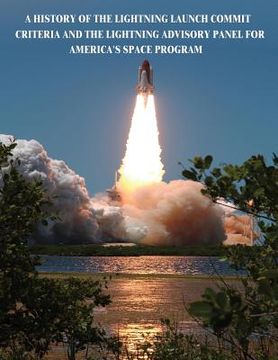A History of the Lightning Launch Commit Criteria and the Lightning Advisory Panel for America's Space Program (en Inglés)
Reseña del libro "A History of the Lightning Launch Commit Criteria and the Lightning Advisory Panel for America's Space Program (en Inglés)"
Since natural and artificially-initiated (or 'triggered') lightning are demonstrated hazards to the launch of space vehicles, the American space program has responded by establishing a set of Lightning Launch Commit Criteria (LLCC) and Definitions to mitigate the risk. The LLCC apply to all Federal Government ranges and have been adopted by the Federal Aviation Administration for application at state-operated and private spaceports. The LLCC and their associated definitions have been developed, reviewed, and approved over the years of the American space program starting from relatively simple rules in the mid-twentieth century (that were not adequate) to a complex suite for launch operations in the early 21st century. During this evolutionary process, a "Lightning Advisory Panel (LAP)" of top American scientists in the field of atmospheric electricity was established to guide it. This history document provides a context for and explanation of the evolution of the LLCC and the LAP. A companion document on the rationale is currently being prepared by the LAP to provide the physical, mathematical, and operational justification for the current LLCC. Lightning that takes place naturally in thunderstorms was recognized as a threat to spaceflight early in the space age, and the early launch rules prohibited flight through thunderstorms. What had not been recognized until Apollo XII was launched in 1969 was that an ascending rocket could "trigger" lightning if it flew into highly electrified clouds, even in the absence of natural lightning. Apollo XII was struck twice by triggered lightning, and as a result, additional rules were added to forbid flying within 5 NM of thunderstorms or through certain non-thunderstorm clouds that experience showed had the potential of being electrified. During the time between Apollo XII and the beginning of the Space Shuttle Program, several important research programs were carried out to learn more about lightning and cloud electricity in Florida, and additional instrumentation was installed at the KSC and Eastern Range (ER). The LLCC were modified for the Skylab program in 1973 and again for the Apollo-Soyuz Test Project in 1975. Expendable launch vehicles (ELV) had their own separate but similar rules. In 1979 the nascent Shuttle program adopted a set of LLCC that included constraints and waivers that were based on surface electric field mill measurements. The ELV rules did not adopt the field mill criteria. In 1987, triggered lightning caused the loss of Atlas/Centaur 67 (AC 67) and its Fleetsatcom payload. A major cause of this accident was the failure of the ELV rules to include a field mill criterion. The Shuttle rules would have prohibited the launch of AC 67. In the aftermath of several investigations and a Congressional Hearing, a lightning "Peer Review Committee", a predecessor of the LAP, was established to guide NASA and the Air Force in the drafting of LLCC and the conduct of associated research. Several major research projects were undertaken, including the first "Airborne Field Mill Program" (ABFM I, 1990-1992) in which direct measurements of electric fields in Florida clouds were made from a specially instrumented aircraft. ABFM I resulted in several improvements to the LLCC, and the lessons learned ultimately led to an even more successful ABFM II campaign a decade later. As new knowledge and additional operational experience has been gained, the LLCC have been updated to preserve or increase their safety and increase launch availability. All launches of ELV and manned vehicles now use the same rules, which simplifies their understanding and application and minimizes the cost of the weather infrastructure to support them. In the future, the processes and procedures that have evolved can be used to facilitate further improvements in both launch availability and safety as new research findings become available.

